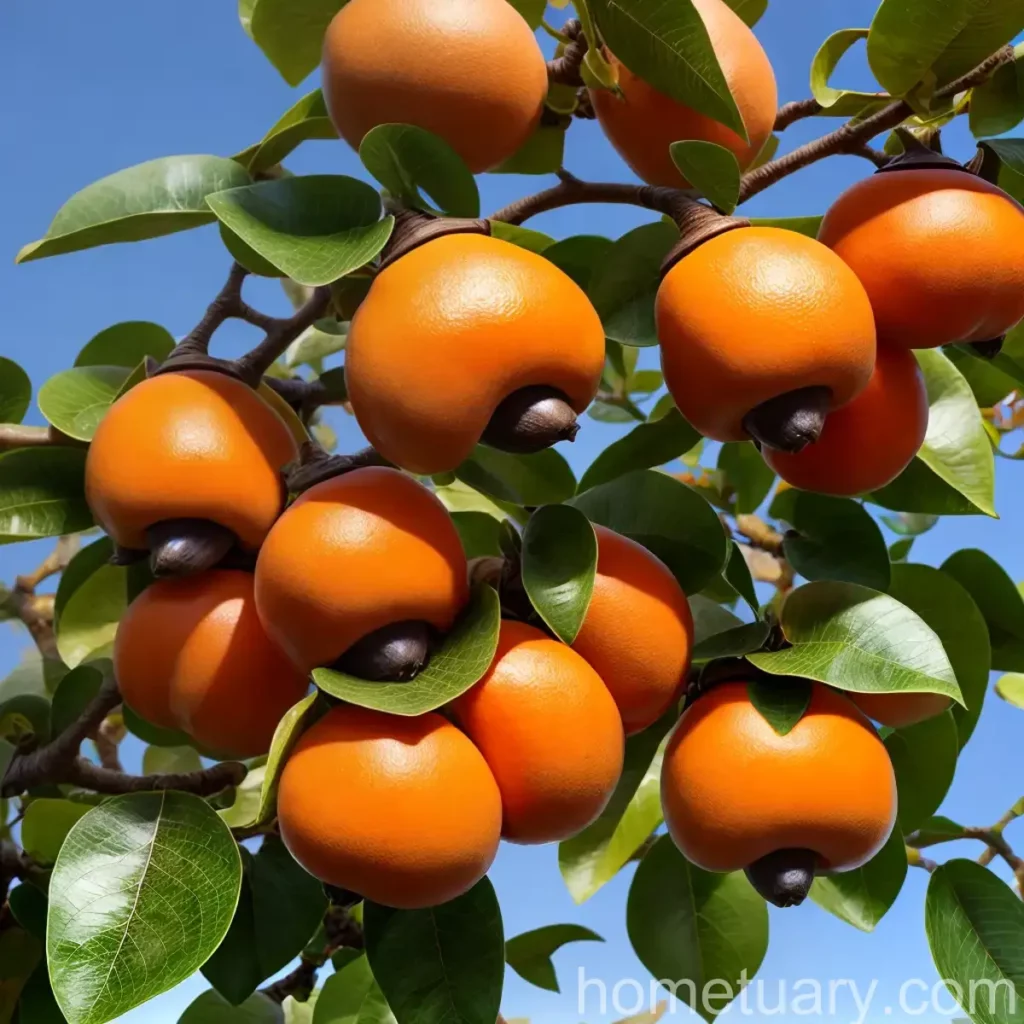The Magnificent Persimmon (Diospyros virginiana)

What is a Persimmon Tree?
The persimmon tree, known by its scientific name Diospyros virginiana, is a deciduous tree native to the eastern United States. It belongs to the genus Diospyros, which comprises over 700 different species across the globe. The persimmon tree is renowned for its delicious fruits and is also valued for its ornamental beauty. Its striking smooth gray bark, glossy green leaves, and vibrant orange fruits contribute to its popularity in both residential and commercial landscapes.
Key Takeaways – Persimmon (Diospyros virginiana)
Before delving deeper into the world of persimmons, let’s summarize some key takeaways about this fascinating plant.
- Scientific Name: Diospyros virginiana
- Common Name: Persimmon
- Family: Ebenaceae
- Origin: Eastern United States
- Fruit Type: Berry
- Fruit Color: Varies from light yellow-orange to dark orange-red
- Flowering Season: Late spring to early summer
- Fruiting Season: Late summer to early fall
- USDA Hardiness Zones: 4-9
- Growth Habit: Can reach heights of 35-60 feet
The persimmon tree is cherished for its sweet and flavorful fruit, which can be enjoyed fresh or used in various culinary applications. However, successful cultivation requires an understanding of the plant’s specific requirements.
Culture
Uses
- Edible Fruit: The persimmon fruit is the most notable product of the tree, prized for its sweet, honey-like flavor and versatile culinary uses.
- Ornamental: In addition to its fruit, the persimmon tree is valued for its ornamental appeal, making it a popular choice in landscape design.
- Wood: While less common, the wood of the persimmon tree is dense and hard, making it suitable for crafting golf club heads, billiard cues, and other specialty items.
Growing Conditions
Water
The persimmon tree has moderate water needs, particularly during the establishment phase. Adequate irrigation is crucial for the tree’s growth and fruit development. However, it is important to avoid overwatering, as excessive moisture can lead to root rot and other issues.
Sunlight
This tree thrives in full sun, requiring a minimum of 6-8 hours of direct sunlight daily. Adequate sunlight is essential for fruit production and overall plant health.
Soil
Persimmon trees prefer well-draining, moderately fertile soil. They can tolerate a range of soil types, from sandy to clay-based, but soil with good drainage is critical to prevent waterlogged conditions that can harm the roots.
Fertilizer
Regular fertilization is beneficial for persimmon trees, especially when they are young. A balanced fertilizer with an N-P-K ratio of 10-10-10 can be applied in early spring before new growth begins.
Pruning
Pruning is an important aspect of persimmon tree care, contributing to fruit production, shape control, and overall plant health. Some key aspects of pruning include:
- Training: Young trees should be trained to establish a strong framework of branches.
- Thinning: Regularly thinning out branches can improve light penetration and air circulation within the canopy, promoting fruit development and reducing disease risk.
- Size Control: Regular pruning helps manage the tree’s size and shape, making it more manageable for cultivation and maintenance.
Propagation
Persimmon trees are commonly propagated through the following methods:
- Seed Propagation: While viable seeds can be harvested from mature fruits, keep in mind that seed-grown trees may not retain the exact characteristics of the parent tree.
- Grafting: Grafting is a popular method to ensure that the new tree inherits the desired qualities and characteristics of the parent plant. Common grafting techniques include T-budding and whip-and-tongue grafting.
Container Popularity for Persimmon Trees
Growing persimmons in containers has gained popularity among home gardeners, allowing those in cooler climates or urban settings to enjoy these delightful fruits. When growing persimmons in containers, select a large container with excellent drainage and use a well-draining potting mix. Ensure that the container receives ample sunlight and regular watering. Additionally, container-grown persimmon trees may benefit from occasional fertilization during the growing season.
Common Diseases
Disease Diagnosis
Persimmon trees may be susceptible to various diseases, including:
- Anthracnose: This fungal disease can cause leaf spots, shoot blight, and fruit rot.
- Canker Diseases: Cankers often appear as sunken, discolored lesions on the trunk or branches, potentially leading to dieback if left untreated.
- Root Rot: Excessive soil moisture can lead to root rot, causing symptoms such as wilted foliage and stunted growth.
Common Pests
Persimmon trees may face infestations from pests such as:
- Aphids: These small, soft-bodied insects can cluster on new growth, leading to distorted leaves and reduced plant vigor.
- Scale Insects: Scale insects can be a nuisance, causing yellowing foliage and overall decline in tree health.
- Spider Mites: These tiny pests can cause noticeable stippling on leaves, leading to a weakened appearance and reduced photosynthetic efficiency.
Botanist’s Tips
To protect persimmon trees from diseases and pests, implement the following preventive measures:
- Regularly inspect the tree for signs of disease or pest infestations.
- Promote good air circulation within the canopy through proper pruning and spacing.
- Avoid excessive moisture around the root zone, which can contribute to disease development.
Fun Facts
- The persimmon fruit is a good source of fiber, vitamins A and C, and various beneficial antioxidants.
- The tree’s botanical name, Diospyros, translates to “divine fruit” or “divine food.”
- Some persimmon varieties are known for a unique astringency, which disappears as the fruits ripen.
Links to External Resources
For more information on persimmons, explore the following resources:
- Growing Persimmons
- Persimmon Tree Care Guide
- Persimmon Tree Diseases and Pests
- Harvesting and Using Persimmons
- Nutritional Benefits of Persimmons
In conclusion, the persimmon tree holds not only delicious rewards in the form of its delectable fruit but also adds aesthetic charm to diverse landscapes. Cultivating persimmons, whether in the ground or in containers, offers an enriching experience for gardeners and enthusiasts alike. Through an understanding of its specific needs and attributes, one can savor the joys of growing and enjoying the bounties of the magnificent persimmon tree.















